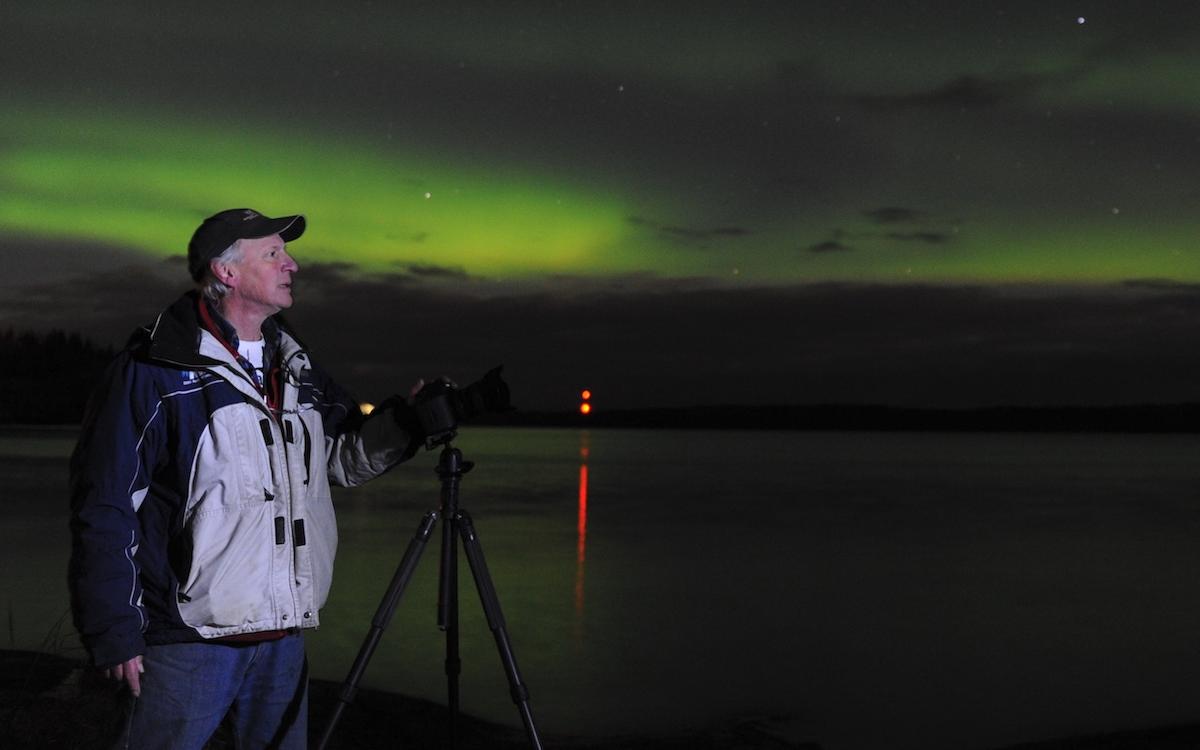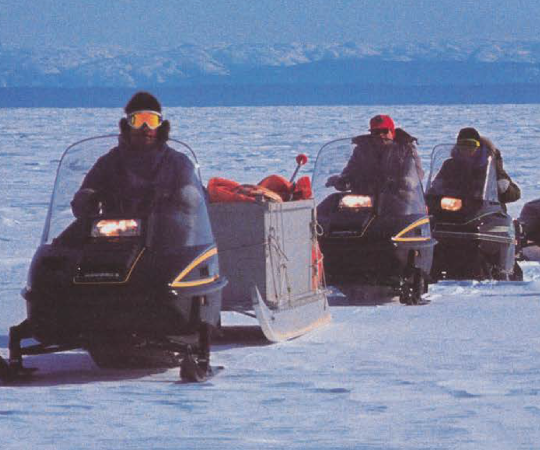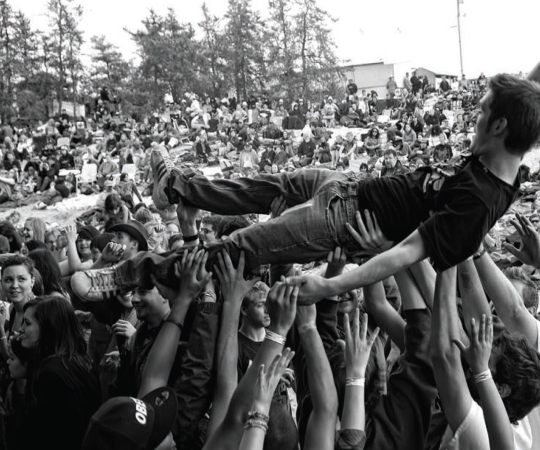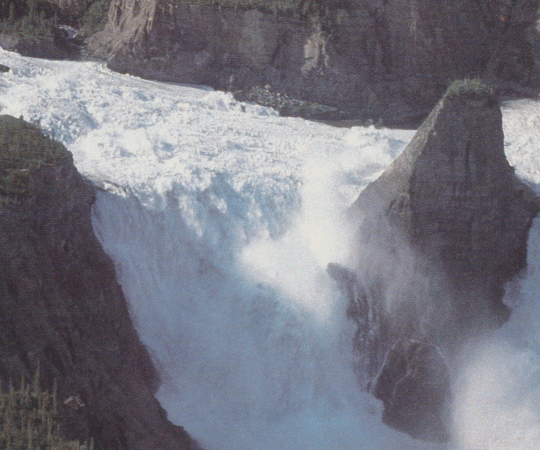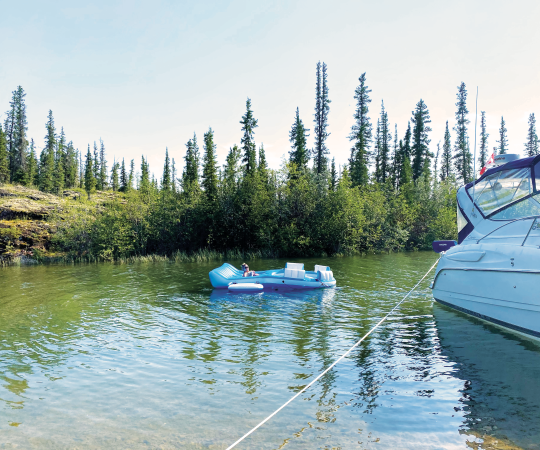Out behind the Air Tindi float base, we wait as the clouds pass overhead. It isn’t the best night for photographing aurora in Yellowknife’s Old Town. Bill Braden takes a drag on his cigarette with an ungloved hand in defiance of the cold. He’s contemplating his preferred photo composition.
“I’m looking for a storytelling picture,” he says. “I need to get some other ingredients in there to tell me more than just a lovely aurora display.”
He likes to emphasize people, geography—a sense of place in his pictures—in contrast to the “big sky” feeling some celestial photographers prefer. It’s a way to ground the northern lights with the world happening underneath. To bring them down to earth.
The former MLA, author, reporter, art gallery owner and Up Here contributor has been shooting images of the aurora borealis for over 50 years. He began with a black-and-white snapshot taken in 1967 for a photo contest in the Edmonton Journal.
“I won!” he says. “That was it for me. I was hooked.”
This past March, Braden created a photography workshop as part of Yellowknife’s new mid-winter aurora festival, Naka. Now, he’s expanded that workshop with fellow photographers Lenora Barrett and Martine Male into a twice-weekly lesson put on by SunDog Adventures. Participants pay $75 and arrive with tripod, digital camera, and warm clothing. By night’s end, they leave with their handiwork etched onto digital memory.
The first photo image of the northern lights was produced by researchers at the University of Saskatchewan in 1949 using an SCR-270 radar on loan from the American military. In a coincidence of history, it was the very same long-distance radar antenna that first detected the attack on Pearl Harbour, 45 minutes before the 1941 invasion. Constellations of cameras both scientific and recreational now open their lenses every night across the North to capture what Robert Service called the cotillion dance of “silver feet, and pierced with a blinding blaze.”
Conservatively, there are tens of millions of photographs of this captivating natural phenomenon. Thousands of visitors will arrive in the North again this winter to capture even more. Why? What is it they’re hoping to see when looking through their cameras?
“The Grand Canyon, the Pyramids of Egypt, these extraordinary things that most people, when they hear about them, they long to see them,” says Braden. “We have one.”
Why are the aurora so photographed? Let’s pause to reflect on the inherent absurdity of the question. Aurora are the result of solar wind charging particles in Earth’s magnetosphere, resulting in an ionized display of complex light and colour at the polar regions. What is it, in other words, that people find captivating about a ballet of colours from outer space dancing in the sky? The answer is inherent in the question.
There’s only Bill Braden and myself out hunting for the lights on this snowy October evening. The K-index—a global forecast for measuring geomagnetic storms—is at two and the black sky is dammed with clouds.
Last aurora season, just under 35,000 people came to the Northwest Territories to view the lights. On a clear night out in the field, Braden estimates each of those visitors could snap at least 50 photos. It wouldn’t be a stretch to assume there are two million new aurora photos— give or take—shot each year in the NWT. A sublime display of cosmic energy is mined from the sky. The spectacular becomes common.
Steadily, year-by-year, the aurora industry in the territories is growing. So too are photographs of the jewelled sky. The expertise and expense needed to take a decent picture have fallen sharply in the past decade. High-functioning digital cameras are cheap these days.
Smartphone cameras are producing increasingly vivid night imagery. Film used to be the biggest challenge to photographing the northern lights. Colour, speed, exposure, it all had to be guessed at in the field. Confirmation only came later in the lab. “It was all chemistry... all sorts of dark things going on,” says Braden. “It was beyond people.”
Now, exquisite images can be taken dozens of times with the click of a button and reviewed in real-time out in the field. Guides to snapping the perfect shot are likewise ubiquitous. There are apps to predict the best times to look up. Weather satellites aimed at the sun can pinpoint the precise arrival times of magnetic storms erupting from the sun. It sort of, well, ruins the magic. Doesn’t it?
“Even if you’ve been here all your life, if you see a really stunning display of aurora it stops you in your tracks,” says Braden. “It’s like a fireworks show or watching a campfire. It’s forever changing and you’re wondering what’s going to happen next.”
It’s about being there, underneath the majestic flicker, in the cold still of the night and feeling the dry snow crunching underfoot. Capturing that photo of the northern lights is about preserving how you feel at that moment, says Braden.
“Look at that, it’s opening up.” The clouds are clearing. A faint green glow emerges over our heads. “Well, what do you think. Should we try it?”

HOW TO SHOOT THE NORTHERN LIGHTS
A guide to aurora photo perfection.
- Use a wide lens and an aperture f3.5 or lower to get as much light into the camera as possible.
- Invest in a decent tripod. A heavy stand will secure your camera out in the wild.
- Set ISO between 400 and 1600. Higher numbers are more light-sensitive but will also amplify digital noise.
- Avoid automation. Set your focus manually to infinity and turn off any “image stabilization” function.
- Find an interesting setting to compose your frame. Use the foreground and horizon to tell a story.
- Set an initial exposure time of 15 seconds. Play with different shutter speeds to adjust the darkness.
- Get a headlamp. Useful when fumbling around with camera settings.
- Wait. Accept that you’re at the mercy of the aurora. This leads us to our final tip...
- Dress warm. “Nothing kills a night of taking pictures faster than cold feet,” says Bill Braden.

